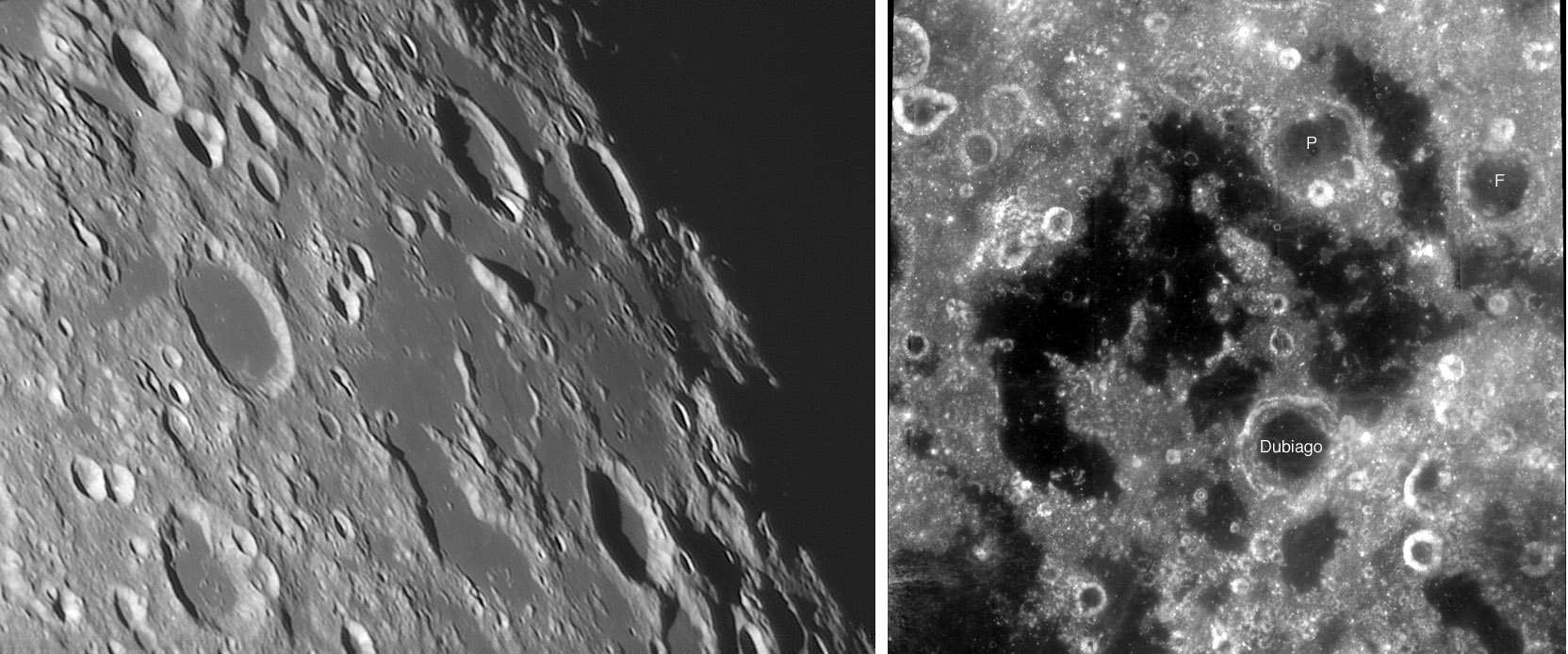Difference between revisions of "August 1, 2009"
(Created page with "__NOTOC__ =What is Undarum?= <!-- ws:start:WikiTextHeadingRule:2:<h1> --> <!-- ws:start:WikiTextLocalImageRule:8:<img src="/file/view/LPOD-Aug1-09.jpg/8290962...") |
|||
| Line 6: | Line 6: | ||
//left image by [mailto:slamm@blueyonder.co.uk Stefan Lammel], Uxbridge, England; right image from Clementine<br /> | //left image by [mailto:slamm@blueyonder.co.uk Stefan Lammel], Uxbridge, England; right image from Clementine<br /> | ||
<br /> | <br /> | ||
| − | The irregular maria are typically small and seem to occur by happenstance. But few things on the Moon don’t have a story, so what is it for Mare Undarum? Stefan’s best-ever from Earth image shows that Undarum is a roughly circular (if you mentally correct for foreshortening or look at the Clementine image) patch of dark maria that fill low spots (ancient craters probably) and, like Australe, younger craters (Dubiago, Condorcet P & F, and Firmicus at left center). The circular shape suggests that the mare material fills a small lunar basin but there is no evidence, other than the lavas themselves, to suggest a prior depression. Indeed, topomaps show this to be a high area, and a crustal thickness [mailto:tychocrater@yahoo.com Chuck Wood]<br /> | + | The irregular maria are typically small and seem to occur by happenstance. But few things on the Moon don’t have a story, so what is it for Mare Undarum? Stefan’s best-ever from Earth image shows that Undarum is a roughly circular (if you mentally correct for foreshortening or look at the Clementine image) patch of dark maria that fill low spots (ancient craters probably) and, like Australe, younger craters (Dubiago, Condorcet P & F, and Firmicus at left center). The circular shape suggests that the mare material fills a small lunar basin but there is no evidence, other than the lavas themselves, to suggest a prior depression. Indeed, topomaps show this to be a high area, and a crustal thickness [http://www.ipgp.fr/~wieczor/CrustalThicknessArchive/Model3(LP150Q)/basins_dual.pdf map] gives no evidence of thinning as under impact basins. To get a clue to why Undarum exists we need a more regional perspective. Undarum, like Spumans, Bonitatis and Anguis are all piddly little mare patches outside of the main mountainous rim of the Crisium impact basin. Although it is hard to see south of Crisium, a larger basin ring is clear to the north of the basin. All of these little maria are in the moat between two Crisium basin rings. Deep fractures associated with the basin allowed magma easy rise to the surface, and it ponded in the low spots.<br /> |
| + | <br /> | ||
| + | [mailto:tychocrater@yahoo.com Chuck Wood]<br /> | ||
This is a classic LPOD from [http://www.lpod.org/?m=20070118 Jan 18, 2007]<br /> | This is a classic LPOD from [http://www.lpod.org/?m=20070118 Jan 18, 2007]<br /> | ||
<br /> | <br /> | ||
Revision as of 19:44, 1 January 2015
What is Undarum?

//left image by Stefan Lammel, Uxbridge, England; right image from Clementine
The irregular maria are typically small and seem to occur by happenstance. But few things on the Moon don’t have a story, so what is it for Mare Undarum? Stefan’s best-ever from Earth image shows that Undarum is a roughly circular (if you mentally correct for foreshortening or look at the Clementine image) patch of dark maria that fill low spots (ancient craters probably) and, like Australe, younger craters (Dubiago, Condorcet P & F, and Firmicus at left center). The circular shape suggests that the mare material fills a small lunar basin but there is no evidence, other than the lavas themselves, to suggest a prior depression. Indeed, topomaps show this to be a high area, and a crustal thickness map gives no evidence of thinning as under impact basins. To get a clue to why Undarum exists we need a more regional perspective. Undarum, like Spumans, Bonitatis and Anguis are all piddly little mare patches outside of the main mountainous rim of the Crisium impact basin. Although it is hard to see south of Crisium, a larger basin ring is clear to the north of the basin. All of these little maria are in the moat between two Crisium basin rings. Deep fractures associated with the basin allowed magma easy rise to the surface, and it ponded in the low spots.
Chuck Wood
This is a classic LPOD from Jan 18, 2007
Technical Details
7 Nov 2006, 00:27 UT. 10″ f4.8 Newtonian, DMK 21AF04, 4x PowerMate, red filter, Registax v4, PSE 5, 60fps, 1/60s, 600/5000, MAP: 29×64.
Related Links:
Rükl plate 38
Stefan’s website
COMMENTS?
Click on this icon File:PostIcon.jpg at the upper right to post a comment.



